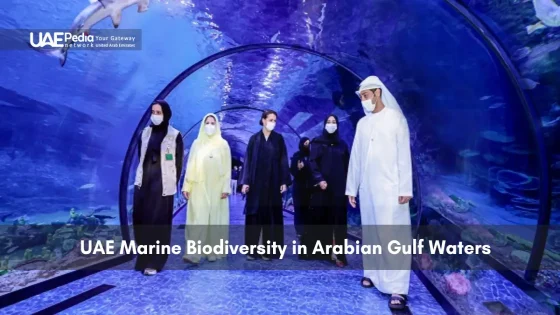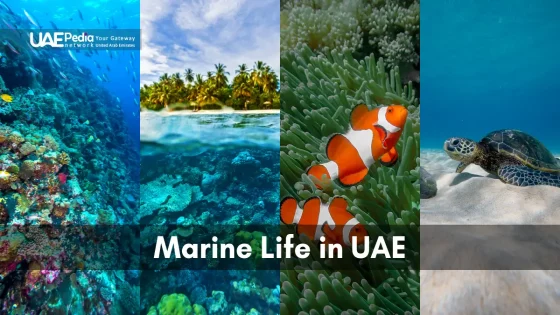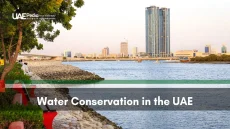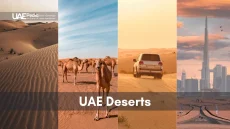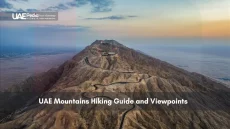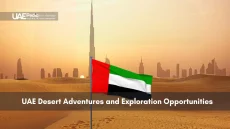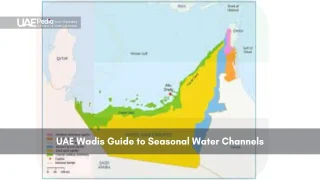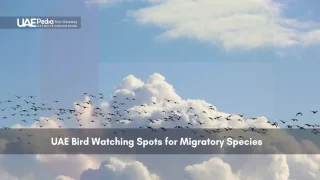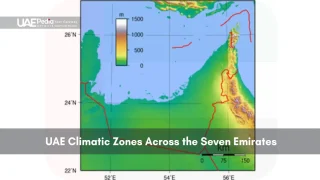What if we told you one of Earth’s most extreme environments teems with over 500 species of fish? The sun-soaked waters of the Arabian Gulf defy harsh temperatures and salinity levels to host vibrant coral reefs, sea turtles, and even dugongs. It’s a living laboratory where tradition meets technology—and the UAE is leading the charge.
Enter the Jaywun, a floating tech hub that’s rewriting how we study this delicate ecosystem. This research vessel uses sonar mapping and DNA sampling to track everything from plankton patterns to underwater archaeology. Think of it as a detective ship, piecing together clues about how life adapts in these turquoise depths.
Abu Dhabi’s coastal heritage—centuries of pearl diving and fishing—fuels today’s conservation efforts. Modern Emirati scientists work alongside global experts, blending ancestral knowledge with robotics and AI. Together, they’re crafting strategies to protect species while balancing economic growth.
In this article, we’ll explore:
- How cutting-edge tools map habitats invisible to the naked eye
- Why this region’s findings impact global ocean studies
- Ways coastal communities shape environmental stewardship
Introduction: Exploring the UAE’s Marine Environment
Picture turquoise waves hiding secret gardens—where coral labyrinths pulse with life and ancient seagrass meadows sway like underwater wheat fields. This isn’t a tropical fantasy—it’s the reality of the Arabian Gulf’s edge, where shimmering waters meet hyper-modern coastlines. These ecosystems aren’t just pretty postcards—they’re climate warriors, absorbing carbon and sheltering species found nowhere else.
Setting the Context of Arabian Gulf Waters
Imagine a sea that’s both spa and survival test—water temperatures here swing from bathtub-warm winters to near-hot tub levels in summer. Yet this liquid paradox nurtures over 30% of the world’s dugong population. Abu Dhabi’s Eastern Mangrove Lagoon proves it: kayak through its quiet channels at dawn, and you’ll spot flamingos wading beside blue-swimmer crabs.
Key Marine Species and Ecosystem Highlights
The real stars? Ghostly hawksbill turtles gliding past neon parrotfish, while 600-year-old coral colonies filter the currents. “These reefs are living history books,” says a researcher at the Sheikh Zayed Protected Areas Network. Conservation here isn’t just about species—it’s safeguarding cultural heritage, from pearl-diving traditions to futuristic eco-resorts.
Local efforts get global muscle through partnerships like the Global Ocean Alliance. Take the Dubai Desert Conservation Reserve—yes, desert—where scientists study how arid and aquatic ecosystems interact. It’s all hands on deck: fishermen-turned-citizen-scientists now tag fish, while AI maps seagrass health from space.
Geological and Historical Insights of the Arabian Gulf
Let’s rewind 20,000 years—when mammoths still roamed Earth and the Gulf looked nothing like today. What’s now shallow turquoise waters was a dusty river valley during the Last Glacial Maximum. As ice sheets melted, rising seas flooded the basin, creating the unique profile we see now. This liquid time capsule holds clues to how landscapes—and life—adapt to planetary shifts.
Formation of the Modern Gulf and Its Unique Profile
The Gulf’s bathtub-shallow depths—averaging just 35 meters—tell a story of dramatic comebacks. During ice ages, it drained completely, leaving salt flats and sunken riverbeds. When waters returned, they sculpted a mosaic of sandbanks and coral platforms. The Strait of Hormuz acts like a liquid gatekeeper, controlling how ocean currents mix nutrients into these sheltered seas.
| Period | Key Event | Sea Level Change | Impact |
|---|---|---|---|
| Last Glacial Maximum | Complete drainage | -120 meters | Exposed river systems |
| Early Holocene | Rapid flooding | +2 meters/year | Coastal habitats formed |
| Recent Times | Stabilization | Current levels | Modern ecosystems emerged |
Impact of Climate Patterns and Sea-Level Changes
Summer heat here isn’t just a weather report—it’s a habitat architect. Water temperatures topping 36°C (97°F) forced species to evolve heat-resistant traits. In Abu Dhabi’s coastal areas, fossilized coral beds reveal how reefs migrated during past warm periods. These natural archives help scientists predict how today’s ecosystems might handle climate change.
Monsoon winds and river sediments also shaped the Gulf’s identity. Winter shamal winds stir up nutrients, creating feeding frenzies for fish. Meanwhile, ancient floods left behind mineral-rich mudflats—now vital nurseries for crustaceans and shorebirds.
Understanding UAE Marine Biodiversity
Think of the Gulf’s waters as nature’s ultimate survival challenge—where life doesn’t just endure, but thrives with flair. This liquid arena hosts 1,200+ fish species, from flashy butterflyfish to camouflaged stonefish. Coastal zones near Abu Dhabi’s intricate shorelines reveal seagrass meadows spanning 3,000 km²—critical nurseries for dugongs and sea turtles.
Diversity of Species and Habitats
Ever seen a pearl oyster filter seawater? Or watched flamingo-tongue snails graze on coral? These specialists share space with 65 types of hard corals. Mangroves along sheltered bays shelter juvenile fish, while sandy bottoms host darting gobies. Each habitat acts like a neighborhood—distinct, yet interconnected.
Role of Coral Reefs, Seagrass Beds, and Mangroves
Coral reefs here work overtime. They buffer coastlines from storms, absorb carbon, and host 25% of all marine species. Seagrass? It’s the unsung hero—producing 10 liters of oxygen daily per square meter. Mangroves filter pollutants while trapping 4x more carbon than rainforests. Together, they form a triple defense against climate change.
Evolutionary Adaptations in an Extreme Environment
Survival here demands creativity. Corals produce sunscreen-like proteins to handle 36°C heat. Fish like the Arabian killifish evolved kidneys that process saltwater 3x faster than freshwater cousins. “These adaptations aren’t quirks—they’re masterclasses in resilience,” notes a researcher studying Abu Dhabi’s hypersaline lagoons.
Advancements in Marine Research and Technology
Imagine a floating laboratory where robotic arms collect sediment samples while AI deciphers fish migration patterns. This isn’t sci-fi—it’s the reality aboard the Jaywun, a 50-meter research marvel redefining how we explore the Arabian Gulf. Equipped with tech that would make James Bond’s Q envious, this vessel cracks open secrets hidden beneath turquoise waves.
The Pioneering Jaywun Research Vessel
Step inside its labs: DNA sequencers identify rare species in hours, not weeks. A remotely-operated submarine vehicle (ROV) films coral reefs at 1,000-meter depths—streaming footage to scientists worldwide. “We’re not just observing ecosystems,” says the Ocean World Discovery project lead. “We’re reverse-engineering how life thrives in extreme conditions.”
The ship’s secret weapon? Hyperlocal water quality sensors. They track temperature shifts and oxygen levels across 15 study areas simultaneously. This real-time data helps predict how warming seas might impact fish stocks. In Abu Dhabi’s coastal zones, these insights shape fishing quotas that balance livelihoods with sustainability.
But the Jaywun isn’t all gadgets. Its sediment analyzers reveal centuries of climate history in a single core sample. Energy-efficient systems onboard mirror the UAE’s push for green innovation. From mapping seagrass meadows to testing reef restoration techniques, every voyage writes new chapters in ocean management playbooks.
As dusk falls over the Arabian Gulf, researchers aboard this high-tech ark compile findings that could safeguard our planet’s liquid frontiers. Because understanding today’s waves is the first step to riding tomorrow’s tides.
Marine Protection Initiatives and Conservation Efforts
Ever wonder how ancient pearl diving traditions shape modern ocean guardianship? Today, 28% of Abu Dhabi’s territorial waters fall under strict safeguards—a network of 16 protected zones where fishing boats share waves with conservation drones. These aren’t just lines on a map—they’re lifelines for creatures like the endangered green turtle and commercially vital hamour fish.
Guardians of the Gulf: Laws That Work
Federal Law No. 24 acts like a superhero cape for the Arabian Gulf. Since 1999, it’s banned dumping industrial waste and restricted destructive fishing gear. The results? Al Yasat Reserve saw a 40% jump in fish populations after trawling bans. Check out how three key areas stack up:
| Protected Area | Key Species | Unique Feature | Success Metric |
|---|---|---|---|
| Marwah Reserve | Hawksbill turtles | Deep-sea coral nurseries | 85% nest survival rate |
| Al Yasat | Hamour fish | No-take zone since 2017 | 200% biomass increase |
| Ras Al Khor | Flamingos | Urban mangrove revival | 12,000+ wintering birds |
Cleaning House—Literally
Here’s a game-changer: 93% reduction in plastic bags since 2020 fees began. Coastal cleanups now recycle fishing nets into park benches—over 8 tons repurposed last year. “We’re turning problems into solutions,” says a Dubai-based environmental officer. Satellite monitors track illegal dumping in real-time, while AI predicts algae blooms before they choke fish.
From pearl divers to policy makers, the region proves protection isn’t about saying “no”—it’s about smarter “yes.” Next time you spot a dolphin off Jumeirah, know that entire ecosystems have backup.
Challenges: Climate Change and Pollution Impacts
Imagine a summer day so hot it literally sucks oxygen from the water—this isn’t dystopian fiction, but reality for coral communities near Abu Dhabi. Seasonal swings here turn turquoise waves into survival obstacle courses. When temperatures spike above 36°C (97°F), oxygen levels plummet, leaving species gasping in waters that feel more like broth than a habitat.
When Heat Steals Breath
A 2023 study tracked oxygen drops of 30% during summer peaks in protected zones. “It’s like running a marathon while breathing through a straw,” explains a marine physiologist studying heat-stressed parrotfish. Hypoxia events now last 40% longer than in the 1990s—and affect 3x more coastal area.
Check the numbers:
| Year | Hypoxic Zone Size (km²) | Avg. Summer Temp | Coral Bleaching Events |
|---|---|---|---|
| 2010 | 52 | 34.1°C | 2 |
| 2020 | 89 | 35.8°C | 5 |
| 2023 | 117 | 36.4°C | 7 |
Warmer seas also disrupt currents that flush out stagnant water. Researchers found dead zones creeping into vital seagrass nurseries—critical for dugongs and turtles. “We’re seeing domino effects,” notes a conservation biologist. “Lose oxygen here, lose life there.”
The fix? Smarter coastal management and reef-safe sunscreen laws show promise. But time’s ticking faster than a bleaching coral’s stress clock. Every degree matters in this liquid balancing act.
Sustainable Blue Growth and Global Partnerships
What if plastic waste could become building materials instead of ocean trash? Abu Dhabi’s Rebound Plastic Exchange answers this—a digital marketplace turning 12,000 tons of discarded plastic into raw materials yearly. This initiative flips the script on pollution, connecting recyclers with manufacturers needing eco-friendly inputs. “We’re creating value from what was once worthless,” says a project lead at the exchange headquarters.
Innovative Plastic Reduction Initiatives and Circular Economy
Circular thinking now shapes coastal protection. Fishing nets retrieved from the Arabian Gulf get shredded into park benches, while 3D-printed coral structures made from recycled bottles anchor new reef growth. The math works: every ton of repurposed plastic saves 2.5 tons of CO2 emissions. Check how key programs stack up:
| Initiative | Partners | Annual Impact |
|---|---|---|
| Plastic-to-Fuel Conversion | Dubai Municipality | 500k liters produced |
| Beach Cleanup Tech | Our Ocean Conference | 83km coastline cleared |
| Eco-Packaging Shift | Global Retail Chains | 47% less single-use plastic |
International Collaborations and Global Ocean Alliances
The Global Ocean Alliance’s 30×30 goal—protecting 30% of seas by 2030—gets muscle from Emirati partnerships. Satellite tracking systems developed with NASA pinpoint illegal fishing, while joint ventures with Norwegian firms test floating wind turbines. “Collaboration multiplies impact,” notes an Our Ocean Conference delegate. These alliances prove healthy habitats fuel economies—from algae-based biofuels to carbon-absorbing seagrass projects.
Abu Dhabi’s protected areas now serve as living labs for global researchers. Last year’s biodiversity summit birthed 14 cross-border projects, including AI-guided turtle patrols and solar-powered desalination plants. As climate pressures mount, these shared efforts rewrite how we balance ecological needs with human progress.
Final Reflections on Preserving Our Marine Legacy
Imagine a future where vibrant coral cities thrive alongside floating solar farms—where every fishing net tells a story of renewal. This vision drives the region’s blueprint for balancing conservation with growth. Cutting-edge research meets ancestral wisdom here, creating models that inspire global ocean stewardship.
Rising temperatures and plastic tides test these waters, but integrated strategies show promise. From Abu Dhabi’s emission-slashing targets to AI-guided patrols in protected zones, solutions emerge where science and community collide. Shifting currents now power climate studies, revealing how species adapt to environmental shifts.
Global alliances amplify local wins. Fishermen share data with NASA-funded satellites, while recycled plastics become artificial reefs. Each innovation proves that healthy ecosystems fuel economies—and that every coastal resident holds a piece of the puzzle.
Our shared responsibility? Keep curiosity alive. Explore seagrass meadows through citizen science apps. Support brands using ocean-safe packaging. Together, we can ensure tomorrow’s tides carry stories of resilience, not regret. The tools exist—the time to act is now.
Coral reefs act as underwater cities sheltering 25% of marine life—from tiny damselfish to blacktip reef sharks. Mangroves? They’re coastal superheroes filtering pollutants, trapping carbon, and serving as nurseries for young fish. Without these habitats, entire food chains collapse.
Imagine surviving summer waters hitting 95°F! Creatures here evolved tricks like heat-resistant proteins in corals and “thermal refuges” where dugongs graze deeper, cooler seagrass. But rising temperatures push even these adaptations to the brink—hence conservationists racing to map resilient reefs.
Abu Dhabi’s Mina Zayed port now hosts a “circular economy” hub recycling fishing nets into skateboards. Dubai bans single-use bags, while startups like DGrade turn plastic bottles into apparel. You’ll even find AI-powered drones patrolling coasts to spot trash hotspots!
Absolutely! Choose reef-safe sunscreen, avoid touching corals (they’re alive!), and join beach cleanups. Snorkel responsibly—no chasing turtles. Bonus: Book eco-tours supporting local conservation, like Jubail Mangrove Park’s kayak trails where your fee funds habitat restoration.
This floating lab—launched in 2023—uses sonar mapping and DNA sampling to study everything from deep-sea microbes to shifting fish populations. Its data shapes policies on protected zones and sustainable fishing quotas, giving scientists unprecedented Gulf insights.
Low-oxygen “dead zones” spiked 30% since 2000, worsened by nutrient runoff and warming waters. The result? Mass fish die-offs. Solutions include smart farming to curb fertilizer use and AI systems alerting fishermen to oxygen-rich areas—key for maintaining catch volumes.
